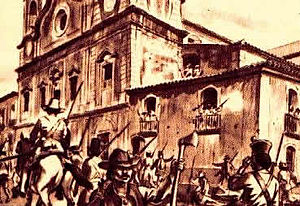
Back Cabanagem Esperanto Cabanagem Spanish Cabanagem Finnish Cabanagem French Cabanagem ID Cabanagem Malay Cabanaige MWL Powstanie Cabanagem Polish Cabanagem Portuguese Кабанажен Russian
This article needs additional citations for verification. (August 2012) |
| Cabanagem Revolution | |||||||
|---|---|---|---|---|---|---|---|
 Cabanagem Revolution | |||||||
| |||||||
| Belligerents | |||||||
|
| |||||||
| Commanders and leaders | |||||||
| |||||||
| Strength | |||||||
| 25,000 insurgents | ||||||
| Casualties and losses | |||||||
| More than 40,000 dead (soldiers, militia, rebels and civilians) | |||||||
The Cabanagem (Portuguese pronunciation: [kabaˈnaʒẽj]; 1835–1840) was a popular revolution and pro-separatist movement that occurred in the then province of Grão-Pará, Empire of Brazil.
Among the causes for this revolt were the extreme poverty of the Paraense people, oppression by the Empire of Brazil, and the political irrelevance to which the province was relegated after the independence of Brazil.[1] The elite agriculturists of Grão-Pará, while living much better, resented their lack of participation in the central government's decision-making, which was dominated by the provinces of the Southeast and Northeast.
The name "Cabanagem" refers to the type of hut used by the poorest people living along the waterways of northern Brazil,[2] principally caboclos, freed slaves, and indigenous people. Their goal was to be more involved in government decisions, ultimately seeking the economic development of Grão-Pará.[3]
It is thought that 30–40% of the population of Grão-Pará, estimated at 100,000 people, died. In 1833 the Province had 119,877 inhabitants, consisting of 32,751 Amerindians, 29,977 black slaves, 42,000 mixed-race people, and a White minority of 15,000, over half of them Portuguese.[4]
- ^ Harris, Mark (2010). Rebellion on the Amazon: The Cabanagem, Race, and Popular Culture in the North of Brazil 1798–1840. Cambridge Latin American Studies. Vol. 95. Cambridge University Press. ISBN 978-0521437233.
- ^ Pinheiro, Luís Balkar Sá Peixoto (29 May 2022). "Cabanagem: Plural e Radical". Impressões Rebeldes. Fluminense Federal University. Archived from the original on 14 November 2022. Retrieved 27 August 2024.
- ^ Melo, M. de N. S., & dos Santos, M. L. S. (2021). Cabanagem: A história vivenciada na região do Grão-Pará / Cabanage: The history lived in the grand Pará region. Brazilian Journal of Development, 6(12), 103318–103333. https://doi.org/10.34117/bjdv6n12-727
- ^ Chiavenato, Júlio José. "A hora da desforra". Revista História Viva (in Portuguese). Vol. 45. pp. 84–91.